No slide title
Presentation to the
American Meat Institute
OSHA Injury Recordkeeping:
Avoiding Common Mistakes and
"Willful" Citations
Arthur G. Sapper, Esq.
McDermott Will & Emery LLP
Washington, D.C.
Topics Today
1. Status of the OSHA Recordkeeping
Regulations and Their Enforcement
Regulations and Their Enforcement
2. The Ten Most Common
Recordkeeping Errors
3. Five Important Missteps That Can
Lead To "Willful" Recordkeeping
Citations
Status of the OSHA
Regulations and
Their Enforcement
The "New OSHA"
•
"There is a new sheriff in town." –
Secretary of Labor, Hilda Solis
Secretary of Labor, Hilda Solis
•
"We're a regulatory and enforcement
agency and we're going to act like it. …" –
Assistant Secretary David Michaels
Assistant Secretary David Michaels
•
"You are not alone. We have your back
and your fight is our fight … there's a new
sheriff in town." – Jordan Barab, OSHA Deputy
Asst. Secretary
Suspicions About Recordkeeping
• OSHA's new leaders believe that under-
OSHA's new leaders believe that under-
recording of injuries is widespread.
recording of injuries is widespread.
• Mr. Barab co-wrote a 2007 article on the
Mr. Barab co-wrote a 2007 article on the
effects of bonus and other incentive programs on injury recording, entitled "
Cooking the Books."
Cooking the Books."
Suspicions About Recordkeeping
• OSHA's new leaders believe that employers
OSHA's new leaders believe that employers
have many incentives to under-report:
have many incentives to under-report:
– Avoiding being targeted for OSHA inspections;
– Qualifying to bid on and be awarded contracts;
Qualifying to bid on and be awarded contracts;
– Enhancing reputation for business development,
worker morale and community standing purposes;
worker morale and community standing purposes;
– Lowering workers compensation insurance and
Lowering workers compensation insurance and
related medical costs; and
related medical costs; and
– Compensation, bonuses and related incentives.
Compensation, bonuses and related incentives.
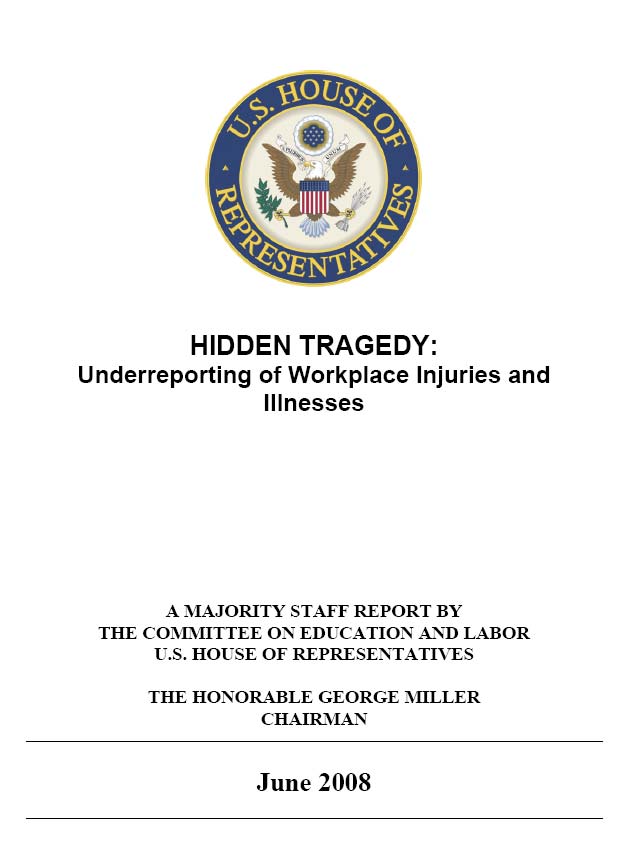
Suspicions About Recordkeeping
• Doctors and their
professional organizations have complained of pressure from employers to under-treat or mistreat injuries to avoid OSHA recordability:
– To use bandages instead
To use bandages instead
– To use over-the-counter
To use over-the-counter
instead of prescription drugs;
– To prescribe narrower
To prescribe narrower
restrictions or no restrictions.
The Results
• National Emphasis Program on Injury &
Illness Recordkeeping;
Illness Recordkeeping;
• Rulemaking to Restore the MSD
• Rulemaking to Require Electronic
Reporting of 300 Logs.
Reporting of 300 Logs.
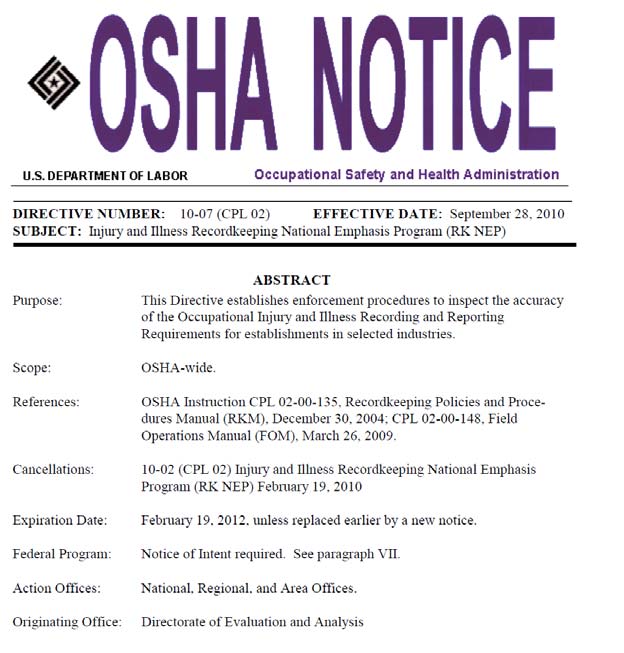
The Recordkeeping NEP
• The new National
The new National
Emphasis Program on Injury & Illness Recordkeeping, first launched 9/30/09
– To cite
recordkeeping violations;
– To take a hard
look at incentive programs
The Recordkeeping NEP
• The NEP was temporarily halted in
The NEP was temporarily halted in
• A lot of time and effort was being spent,
A lot of time and effort was being spent,
but few systemic violations were being found.
• The NEP was revamped and
The NEP was revamped and
relaunched in early October 2010.
relaunched in early October 2010.
The Recordkeeping NEP
• As of Dec. 10, 2010, OSHA had found violations in
almost 60% of 192 high hazard or large workplaces.
almost 60% of 192 high hazard or large workplaces.
• That says little: OSHA may have found no more than
That says little: OSHA may have found no more than
one violation at an inspection.
one violation at an inspection.
• That might be no more than a one percent error rate.
That might be no more than a one percent error rate.
• OSHA's figures also omit the number of willful
OSHA's figures also omit the number of willful
violations found.
violations found.
• So there is no evidence that the NEP is generating a
So there is no evidence that the NEP is generating a
deterrent effect commensurate with its effort.
deterrent effect commensurate with its effort.
The MSD Column Rulemaking
• OSHA has proposed to add a column to the 300
OSHA has proposed to add a column to the 300
log in which to put a check mark to indicate work- related musculoskeletal disorders ("MSDs").
related musculoskeletal disorders ("MSDs").
• That proposal still stands.
That proposal still stands.
• OSHA has, however, "temporarily withdrawn"
OSHA has, however, "temporarily withdrawn" it
from review by the White House's Office of Management and Budget.
Management and Budget.
• The reason: So OSHA can convene a panel of
The reason: So OSHA can convene a panel of
representatives of small businesses to review the proposal.
The MSD Column Rulemaking
• Such a panel is required for "major"
Such a panel is required for "major"
rulemaking actions.
rulemaking actions.
• OSHA's argued that its proposal was not
OSHA's argued that its proposal was not
"major" because it would not add to the number of OSHA recordable cases.
number of OSHA recordable cases.
MSDs are recordable now; they just don't
are recordable now; they just don't
need to be indicated separately.
need to be indicated separately.
• So OSHA may be doing this only to bolster its
So OSHA may be doing this only to bolster its
rulemaking record.
rulemaking record.
Rulemaking to Require Electronic
Reporting of 300 Logs
Reporting of 300 Logs
• In 2010, OSHA invited public comment
and held stakeholder meetings on whether employers should be required to electronically file their 300 logs.
to electronically file their 300 logs.
– Modernization of OSHA's Injury and Illness
Data Collection Process, 75 Fed. Reg. 24505 (2010).
24505 (2010).
The Ten Most
1. Misunderstanding Work
• "[R]estricted work is perhaps the least
"[R]estricted work is perhaps the least
understood and least accepted concept in the recordkeeping system." Keystone Center, "Keystone National Policy Dialogue on Work-Related Illness and Injury Recording" (1989).
• That still is the case.
That still is the case.
1. Misunderstanding Work
• Misconception: A restriction is not
recordable if the employee can still perform useful work, or work within his job description.
useful work, or work within his job description.
• If a physician recommends that a worker not
If a physician recommends that a worker not
perform a work activity that is regularly done weekly, the restriction is recordable – no matter what the worker is actually doing.
matter what the worker is actually doing.
– Example: Welder who can't climb ladders is given
sedentary welding. Recordable?
sedentary welding. Recordable?
– Example: Welder given paperwork to do in the
safety office. Recordable?
safety office. Recordable?
Misunderstanding Work
Restrictions – cont'd
• A restriction is recordable if the employer imposes a
restriction, even if a doctor said that the employee can perform his job.
can perform his job.
• § 1904.7(b)(4)(ii)(A)-(B) states: "Restricted work
occurs when … (A) You keep the employee from
performing [a] routine function[] …; or (B) A physician
… recommends …."
• So supervisors who give employees "mercy"
restrictions or transfers are incurring recordables.
restrictions or transfers are incurring recordables.
• Lesson: Your recordkeeper
Lesson: Your recordkeeper must know what your
supervisors are doing.
2. Assuming That Light Duty Work
Is Not A Recordable Restriction
Is Not A Recordable Restriction
• Misconception: "Light duty" is not a recordable
• OSHA's view: A doctor's recommendation of "light
duty" is presumptively a recordable restriction.
• § 1904.7(b)(4)(vii): If the employer is unable to learn
from the physician that the employee may perform all of his routine job functions or work his entire normally assigned work shift, then the restriction is recordable.
assigned work shift, then the restriction is recordable.
• The only way to rebut the presumption is to call the
The only way to rebut the presumption is to call the
physician and ask if the employee can perform all work activities that he regularly performs weekly.
3. Not Giving Proper Weight To
The Employee's Account
The Employee's Account
• Misconception: A worker's account of an injury may
be disregarded if "no witnesses" were present.
were present.
• The employee is a witness!
The employee is a witness!
• Give the employee's account as much weight as the
Give the employee's account as much weight as the
circumstances warrant.
• Don't ignore it merely because the employee cannot
Don't ignore it merely because the employee cannot
corroborate it; sometimes his statement is enough.
corroborate it; sometimes his statement is enough.
• If it is not enough, document the facts and reasons
indicating why in a memorandum to the case file.
indicating why in a memorandum to the case file.
– Paper is cheap; lawyers are expensive.
4. Excessive Reliance On A Failure
To Immediately Report
• Misconception: A worker's failure to immediately
report an injury, especially contrary to a company rule, means that the injury need not be recorded.
rule, means that the injury need not be recorded.
• That may undermine credibility but it does not mean
That may undermine credibility but it does not mean
that a work-related injury did not occur.
that a work-related injury did not occur.
• Perhaps the worker initially thought that the injury
was too minor to report but found that, upon awakening the next morning, the injury feels worse.
awakening the next morning, the injury feels worse.
• All facts, including the employee's account, must be
fully and fairly considered.
fully and fairly considered.
• Determine whether his account is credible, including
Determine whether his account is credible, including
whether there is convincing countervailing evidence to dispute it.
to dispute it.
5. Misunderstanding Aggravation
– Understandably
• Misconception #1: A work-related
aggravation of a non-work-related injury is recordable only if it is significant in common parlance.
• Misconception #2: An injury that is
99.99% non-work-related is not recordable.
Aggravation – cont'd
• OSHA's regulation in one place says that only
OSHA's regulation in one place says that only
"significant" aggravations are recordable.
"significant" aggravations are recordable.
• § 1904.5(a): An injury is "work-related if an
event or exposure in the work environment
either caused or contributed to the resulting
condition or significantly aggravated a pre-
existing injury or illness."
existing injury or illness."
Aggravation – cont'd
• This is misleading.
This is misleading.
• OSHA's regulations specially define
OSHA's regulations specially define
"significant" as any work incident or
exposure – no matter how minor –
that tips the injury into recordability.
that tips the injury into recordability.
• Worker gets tennis elbow on vacation.
• At work, he picks up a box of pencils.
At work, he picks up a box of pencils.
• That tips his already-precarious elbow
That tips his already-precarious elbow
over the edge.
• It causes him to need medical treatment
or prevents his normal weekly typing.
• Recordable? Apply § 1904.5(b)(4).
Recordable? Apply § 1904.5(b)(4).
OSHA Giveth and OSHA Taketh
Away: The Text of § 1904.5(b)(4)
(4) … A preexisting injury … has been significantly
aggravated …when an event or exposure [at work] results in any of the following: ….
results in any of the following: ….
(iii) [D]ays away from work, or days of restricted
work,…that otherwise would not have occurred but for the occupational event or exposure.
but for the occupational event or exposure.
(iv) Medical treatment…where no medical treatment
was needed for the injury…before the workplace event or exposure, or a change in medical treatment was necessitated by the workplace event or exposure.
event or exposure.
OSHA's Regulations Are
• § 1904.5(b)(4) means that
aggravations that are insignificant in common parlance are "significant" under Part 1904.
under Part 1904.
• "Significant"
"Significant" in § 1904.5(a) is thus
OSHA's Writings Are Misleading
• The preamble describes §
The preamble describes § 1904.5(a) as not
"requir[ing] the recording of cases involving only minor aggravation of preexisting conditions." This is misleading.
This is misleading.
• OSHA officials have said that §
OSHA officials have said that § 1904.5(a)
changes the prior rule. This is wrong.
changes the prior rule. This is wrong.
• OSHA recordkeeping officials I have spoken
OSHA recordkeeping officials I have spoken
to are unable to identify an aggravation recordable under the old regulations but not recordable under the new ones.
recordable under the new ones.
6. Applying or Being Influenced By
Non-OSHA Criteria
• Misconception: Non-OSHA criteria for
work-relatedness, aggravation and restriction, can be used.
restriction, can be used.
• Much is similar, but much is different.
Much is similar, but much is different.
• Often, the same person is required to
Often, the same person is required to
apply different concepts – comp and OSHA – to the same cases, and they get confused.
Non-OSHA Criteria – cont'd
• "Note to § 1904.0: Recording…a work-related
"Note to § 1904.0: Recording…a work-related
injury…does not mean…the employee is eligible for workers' compensation …."
for workers' compensation …."
• Despite this, it is difficult and counter-intuitive to say
Despite this, it is difficult and counter-intuitive to say
that a case is not work-related or aggravated for comp, but is OSHA recordable.
comp, but is OSHA recordable.
Non-OSHA Criteria – cont'd
• Physicians are commonly asked whether a case or aggravation
is work-related.
• This is fine if
This is fine if the question is whether the job play
the question is whether the job play ed any role in
the employee's condition, or tipped it into recordability.
• But often physicians respond that the "preponderant"
respond that the "preponderant" or "major"
cause was non-occupational.
cause was non-occupational.
This m ay reflect the physician's common-sense test for work-
relatedness or aggravation, or that state's workers' compensation criteria, which he may be accustomed to.
h he may be accustomed to.
• Lesson: Be alert for signs that physicians are failing to apply
Lesson: Be alert for signs that physicians are failing to apply
OSHA's definition or approaches to recordkeeping.
oaches to recordkeeping.
Non-OSHA Criteria – cont'd
• This conceptual spillover also affects work
This conceptual spillover also affects work
• Insurers urge that to promote healing,
maintain worker morale and lower compensation costs, workers be kept on the job as much as possible.
• Safety and health managers who succeed in
Safety and health managers who succeed in
keeping injured employees from languishing at home often find it hard to consider the case as an OSHA recordable restriction.
as an OSHA recordable restriction.
7. Common-Sense First Aid Can Be "Medical
Treatment"
• Misconception: Treatments that are "first
aid" in common parlance are "first aid" in OSHA parlance.
OSHA parlance.
• If a treatment is not on OSHA's first aid list, it
If a treatment is not on OSHA's first aid list, it
is recordable medical treatment.
is recordable medical treatment.
• § 1904.5(b)(5)(iii): "Are any other procedures
included in first aid? No, this is a complete list of all treatments considered first aid for Part 1904 purposes."
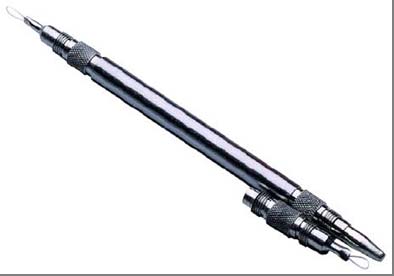
Example: Removing Eye Debris
• Use of a "loop"
Use of a "loop" to snag
foreign bodies on the surface of employee's eye (or a magnet).
eye (or a magnet).
• Maybe better than cotton
swab (no fibers left).
swab (no fibers left).
• One physician-written "Guidelines for Foreign Body
One physician-written "Guidelines for Foreign Body
Removal" states that "the magnet and the nylon loop" are "in the realm of first aid."
are "in the realm of first aid."
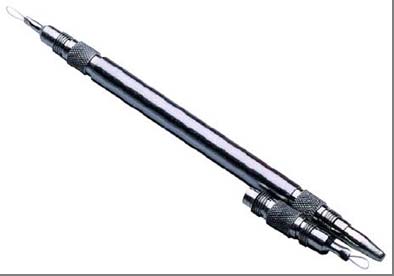
Example: Removing Eye Debris –
• But it's not on
OSHA's first aid list.
OSHA's first aid list.
• "Removing foreign
bodies from the eye"
is first aid "using
only irrigation or a
cotton swab[.]"
• Thus, recordable.
Thus, recordable.
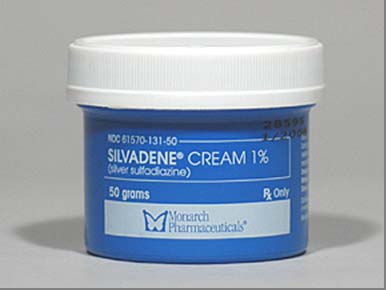
Example: Rx Ointments
• Burn ointment Silvadene available
Burn ointment Silvadene available
in first aid trailer and applied to burns.
• It's not on the first aid list. (It is
even a Rx drug.)
• Therefore, application of Silvadene
Therefore, application of Silvadene
is medical treatment & recordable.
is medical treatment & recordable.
• Irrelevant that –
– Commonly viewed as "first aid";– A doctor did not prescribe it for
use on the employee;
use on the employee;
– Use was unnecessary; another
ointment could have been used.
ointment could have been used.
8. Non-Rx Drugs Prescribed At Rx
Strength
• Error: Overlooking that a non-prescription
drug prescribed by a physician at prescription strength is recordable.
strength is recordable.
• § 1904.5(b)(5)(ii)(A): "[A] recommendation by
a physician…to use a non-prescription medication at prescription strength is…medical treatment for recordkeeping purposes."
treatment for recordkeeping purposes."
Non-Rx Drugs Prescribed At Rx
Strength – cont'd
• Compliance directive (CPL 02-00-135 (2004)):
Compliance directive (CPL 02-00-135 (2004)):
– Ibuprofen (such as Advil™) - Greater than 467 mg
– Diphenhydramine (such as Benadryl™) - Greater
– Naproxen Sodium (such as Aleve™) -
Naproxen Sodium (such as Aleve™) - Greater than
– For other drugs, "contact OSHA, the United States
For other drugs, "contact OSHA, the United States
Food and Drug Administration, their local pharmacist or their physician."
pharmacist or their physician."
Non-Rx Drugs Prescribed At Rx
Strength – cont'd
• This is not very helpful.
This is not very helpful.
• No FDA phone number.
No FDA phone number.
• FDA Orange Book (very difficult to use):
FDA Orange Book (very difficult to use):
• Drugs@FDA website (ditto): <
9. "Unringing the Bell"?
• Misconception: Second opinions from
physicians may always be relied upon.
physicians may always be relied upon.
• Relying on a second opinion is seemingly
Relying on a second opinion is seemingly
• § 1904.7(b)(3)(ii) & (b)(4)(viii): "If you receive
recommendations from two or more physicians … you may [decide] which…is the most authoritative, and record the case based upon that recommendation."
that recommendation."
• But these second opinion provisions are more
But these second opinion provisions are more
limited than they appear.
limited than they appear.
"Unringing the Bell"? – cont'd
• OSHA says, in effect, that they apply only to
work-relatedness and aggravation.
work-relatedness and aggravation.
• OSHA interpretation letters: You "may not
OSHA interpretation letters: You "may not
consider a conflicting recommendation once medical treatment [including Rx], days away from work or restricted activity have taken place, even if the subsequent recommendation is more authoritative."
is more authoritative."
• In these cases, you can't unring the bell.
10. Not Tracking Later Events
• Error: Failure to track events after the initial
injury or initial doctor visit. A big problem.
injury or initial doctor visit. A big problem.
• Often, attention is given to an injury when it
Often, attention is given to an injury when it
first occurs – but many things happen later:
but many things happen later:
– Employees go to doctors for follow-ups
Employees go to doctors for follow-ups
without company knowledge;
without company knowledge;
– Records from subsequent doctor visits do
Records from subsequent doctor visits do
not always get into the system and files.
not always get into the system and files.
Not Tracking Later Events – cont'd
– Papers are received but filed without
Papers are received but filed without
being examined for possible OSHA recordability triggers;
recordability triggers;
– Change in treatment can alter the
Change in treatment can alter the
recordability – from first aid to medical treatment, from medical treatment to restrictions, from restrictions to days away;
– Restrictions and days away are not
Restrictions and days away are not
closely tracked and updated on OSHA logs after initial estimates.
logs after initial estimates.
Not Tracking Later Events – cont'd
• OSHA 300 logs are "evergreen"
OSHA 300 logs are "evergreen" and
must be kept updated.
must be kept updated.
• Don't lose touch or focus after initial
Don't lose touch or focus after initial
incident or treatment.
incident or treatment.
• Have an effective system for tracking
Have an effective system for tracking
case developments.
case developments.
• If a document is in your files, or can be
obtained from a doctor or workers comp administrator, it will be used against you.
Five Important
Missteps That Can
Lead To "Willful"
Citations
Employee Compensation
Dependent On Recordables
Dependent On Recordables
• OSHA's NEP instructs inspectors to note
"company policies that may have the effect of discouraging recording on the injury and illness records …. For example, … an awards program tied to the number of injuries and illnesses recorded on the OSHA Log …."
and illnesses recorded on the OSHA Log …."
• This includes competition for group bonuses
This includes competition for group bonuses
– "You cost us our bonus."
"You cost us our bonus."
• It also includes managerial bonuses.
It also includes managerial bonuses.
Intrusion Into Provision of
Healthcare
• Having a supervisor follow the employee into
Having a supervisor follow the employee into
the examination room.
the examination room.
• Offering "suggestions"
Offering "suggestions" on how the doctor
should diagnose or treat injuries:
should diagnose or treat injuries:
– Give medication at non-prescription dosages;
Give medication at non-prescription dosages;
– Use a non-rigid splint instead of a rigid splint;
Use a non-rigid splint instead of a rigid splint;
– Use strips for a cut instead of medical glue or
Intrusion Into Provision of
Healthcare – cont'd
• Discouraging workers from visiting their
Discouraging workers from visiting their
personal physician;
personal physician;
• Telling doctors that you are "recordable
Telling doctors that you are "recordable
• Negotiating narrower or fewer
Negotiating narrower or fewer
restrictions with the doctor.
restrictions with the doctor.
– You may ask –
You may ask – gently – but never
pressure. It's best to avoid this.
pressure. It's best to avoid this.
Discipline of Injured Employees
• Disciplining employees because they are injured as
the result of a violation of a safety rule;
the result of a violation of a safety rule;
– Instead, discipline all employee
Instead, discipline all employee s who violate safety rules,
whether they are injured or not, and document it.
and document it.
• Counting absences due to workplace injuries as
Counting absences due to workplace injuries as
unexcused absences, or assigning demerits or points to such absences.
to such absences.
– Instead, count all absenc
Instead, count all absenc es the same.
Excessive Efforts At Avoiding
Recordables
• Don't go the extra mile to avoid a recordable.
Don't go the extra mile to avoid a recordable.
• Don't latch onto weak excuses to not record.
Don't latch onto weak excuses to not record.
• Adopt this policy instead: When in doubt,
Adopt this policy instead: When in doubt,
record – perhaps with an asterisk.*
– "*Of doubtful recordability."
"*Of doubtful recordability."
– "*Work-relatedness unclear."
– "*Subject to further review."
"*Subject to further review."
• Justify a close non-recording decision with a
Justify a close non-recording decision with a
written explanation in the case file.
written explanation in the case file.
A Little Knowledge Is A
Dangerous Thing
• Making numerous errors even though your
Making numerous errors even though your
recordkeeper was trained in OSHA recordkeeping.
as trained in OSHA recordkeeping.
• Such training is a two-edged sword:
– On the one hand, it shows
On the one hand, it shows that you are trying to comply.
– On the other hand, it suggests
On the other hand, it suggests that whatever violations did
occur were knowing, and thus willful.
occur were knowing, and thus willful.
• OSHA press release: "Although [the company] was
extremely knowledgeable about OSHA recordkeeping requirements, it made many unsupportable [recordkeeping] decisions[.]"
unsupportable [recordkeeping] decisions[.]"
A Little Knowledge Is A
Dangerous Thing – cont'd
• There is no easy way out of the dilemma.
There is no easy way out of the dilemma.
• Audit your logs and interview your
Audit your logs and interview your
recordkeeper to make sure that errors are avoided.
Art Sapper, Top 10 OSHA Recordkeeping
Questions Employers Get Wrong, EHS Today (Sept. 2010) (cover story);
(Sept. 2010) (cover story);
Art Sapper, Will You Be A Target for The New
OSHA Sheriff?: Five Things Employers Should Do To Avoid Willful And Repeated Violations, EHS Today (July 2010);
EHS Today (July 2010);
Art Sapper, The Oft-Missed Step –
Documentation of Safety Discipline, OCCUPATIONAL HAZARDS (Jan. 2006).
(Jan. 2006).

About Art Sapper
• Partner in the OSHA Practice Group in the
Washington, D.C. office of McDermott
Washington, D.C. office of McDermott Will & Emery.
Will & Emery.
• Topped the list of lawy
Topped the list of lawy ers chosen in June 2010 by
EHS TODAY magazine as among "The 50 Most Influential EHS Leaders."
Influential EHS Leaders."
• Contributing editor of and frequent
Contributing editor of and frequent author for EHS Today magazine.
• Former Deputy General Counsel of
Former Deputy General Counsel of the Occupational Safety and Health
Review Commission; former special counsel and assistant general counsel to the Federal Mine Safety and Health Review Commission.
• For nine years an adjunct professor of
For nine years an adjunct professor of law at Georgetown University Law
Center, teaching a graduate course in OSHA law.
e course in OSHA law.
• Has testified several times
Has testified several times before Congress on OSHA issues.
; 202-756-8246.
Don't Let This Happen to You!
Source: https://www.meatinstitute.org/index.php?ht=a/GetDocumentAction/i/67503
Nonparametric Bayes modelling of count processes © 2013 by Antonio Canale and David B. Dunson. Any opinions expressed here are those of the authorsand not those of the Collegio Carlo Alberto. Biometrika Advance Access published October 5, 2013 Biometrika (2013), pp. 1–16 Printed in Great Britain Nonparametric Bayes modelling of count processes
Jerome Schofferman, MDSpine Care Medical Group Long-term Opioid Therapy vs Carol Hartigan, MD Exercise/Cognitive Behavioral New England Baptist Hospital,Harvard Medical School Therapy for Refractory Chronic Low Back Pain SpineLine Section Editor:Robert J. Gatchel, PhD, ABPP University of Texas at ArlingtonArlington, TX









